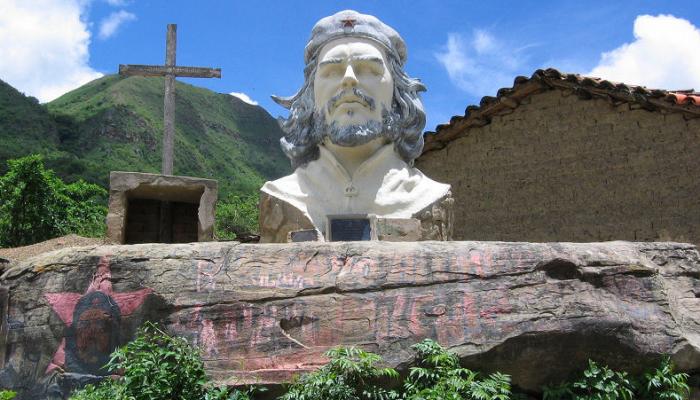-
FrancoBrazilian author Michael Löwy, wrote in his book The Marxism of Che Guevara:
"Che was not only a heroic fighter, but a revolutionary thinker, with a political and moral project and a system of ideas and values for which he fought and gave his life. The philosophy which gave his political and ideological choices their coherence, colour, and taste was a deep revolutionary humanism. For Che, the true Communist, the true revolutionary was one who felt that the great problems of all humanity were his or her personal problems, one who was capable of "feeling anguish whenever someone was assassinated, no matter where it was in the world, and of feeling exultation whenever a new banner of liberty was raised somewhere else. Che’s way of life was the living and concrete expression of this revolutionary Marxist humanism."
The 1960s literary icon Susan Sontag spoke of the "inspiring beautiful legend" that was Che, comparing him to Lord Byron, Emiliano Zapata, and José Martí. Jean-Paul Sartre, a leading existentialist philosopher who knew Che personally, describing him as "the most complete human being of our age."
What, then, is the legacy of Che?
The short answer is that there are many legacies both literary and political. Let’s look at Che’s writing for a moment.
Che’s extensive written legacy includes intellectual writings on radical Marxist politics and social theory, military/guerrilla warfare strategy and tactics, diplomatic memos, books, speeches, magazine articles, letters, poetry and diaries, as well as official documents preserved in Cuban government archives. Che's theoretical work had a profound impact around the globe during the second half of the 20th century, especially in the developing world, where revolutionary organizing and anti-colonial struggles were inspired by his thought and example. His writings have been translated into hundreds of different languages.
The Motorcycle Diaries is a memoir that traces the early travels of "Che" then a 23-year-old medical student, and his friend Alberto Granado, a 29-year-old biochemist. Leaving Buenos Aires, Argentina, in January 1952 on the back of a single cylinder 1939 Norton 500cc dubbed "The Mighty One" or La Poderosa, they set out to explore the South America they only knew from books.
They travelled for nine months by motorcycle, steamship, raft, horse, bus, and hitchhiking, covering more than 8,000 kilometres across places such as the Andes, Atacama Desert, and the Amazon River Basin.
During the formative odyssey Che was transformed by witnessing the social injustices of exploited mine workers, persecuted communists, ostracized lepers, and the tattered descendants of a once-great Inca civilization. The diary ends with a declaration by Che, born into an upper-middle-class family, displaying his willingness to fight and die for the cause of the poor, and his dream of seeing a united Latin America.
The Motorcycle Diaries has been described as a classic coming-of-age story: a voyage of adventure and self-discovery that is both political and personal. Originally marketed by Verso as "Das Kapital meets Easy Rider", The Motorcycle Diaries has been a New York Times bestseller several times.
On the 40th anniversary of Guevara's execution in Bolivia the compilation Che in Verse brought together a diverse collection of 135 poems and songs in tribute to Che Guevara. Celebrated poets such as Pablo Neruda, Allen Ginsberg, Julio Cortázar, Nicolas Guillén, Derek Walcott, Al Purdy, Rafael Alberti, Ko Un, and Yevgeny Yevtushenko devoted the works to, as the book states in its introduction, "celebrate the world’s icon of rebellion".
Another unlikely part of Marxist revolutionary Che’s legacy is theological
The Economist magazine pointed out how Che's post death photos resemble Andrea Mantegna's The Lamentation over the Dead Christ. Thus fixing Chea as a modern saint, whose invocation of the "new man", driven by moral rather than material incentives, smacked of Saint Ignatius of Loyola. Thus Che’s image in death ensured that his appeal would reach way beyond the turbulent university campus and into the hearts of the masses flocking to the worldly, fiery sermons of the liberation theologians. This rung true the year following his death in 1968 when Italy's emerging new breed of Roman Catholic militants, named the Jacques Maritain Circle arranged a memorial mass in Che's honor and Catholic services were held for him in several other countries. These Italian students christened Guevara an "Angela della Pace" – "Angel of Peace." And the potency of his "messianic image", with its "symbolic" and "religious quality", continues to inspire many throughout the World.
Richard Gott a journalist with the Guardian sent a dispatch on the day of Guevara's death stating the following:
It was difficult to recall that this man had once been one of the great figures of Latin America. It was not just that he was a great guerrilla leader; he had been a friend of Presidents as well as revolutionaries. His voice had been heard and appreciated in inter-American councils as well as in the jungle. He was a doctor, an economist, once Minister of Industries in revolutionary Cuba, and Fidel Castro's right-hand man. He may well go down in history as the greatest continental figure since Bolivar.


